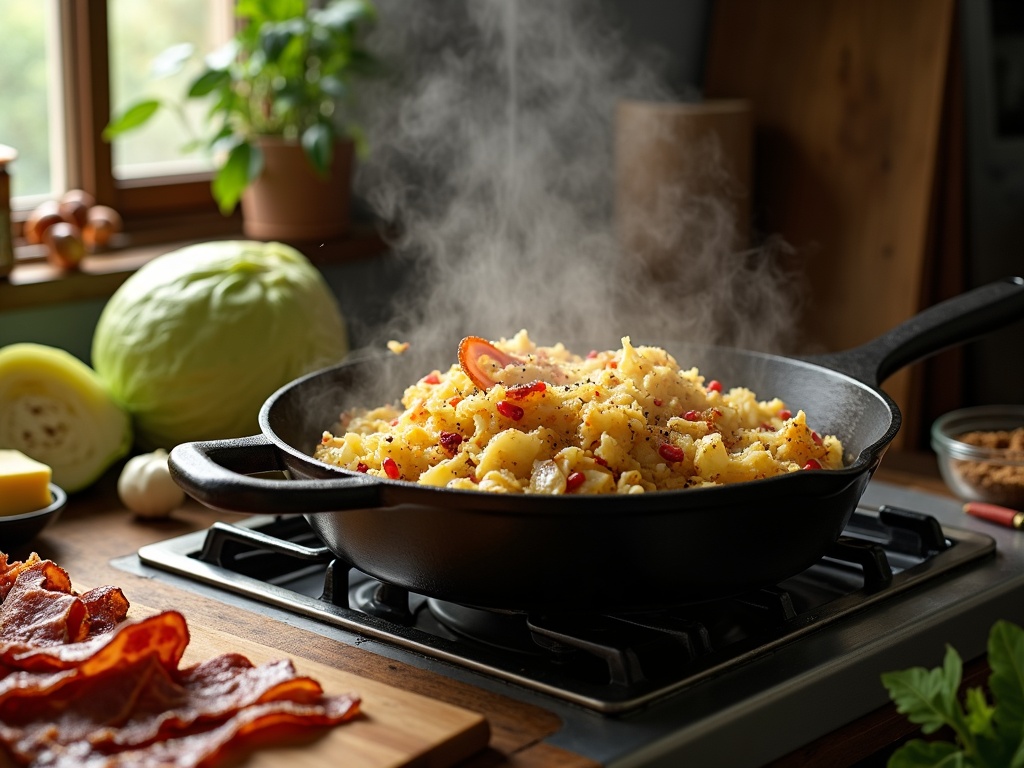Table of Contents
Fried Cabbage: A Flavorful and Affordable Side Dish
Fried cabbage recipe turns ordinary cabbage into a tasty, affordable side dish that’s ready in just 20 minutes using basic ingredients.
The savory, caramelized flavor of fried cabbage complements a wide array of main courses. By frying, the natural sweetness of cabbage is brought forward, and the crisp-tender texture can even convert those who usually aren’t fans of this humble vegetable.
Key Takeaways
- Simple ingredients like cabbage, bacon, onion, garlic, and seasonings make this a wallet-friendly dish.
- Proper technique is crucial: cook bacon until it’s crispy, then sauté onions in the bacon fat before adding the cabbage and cooking until it’s tender but still slightly crunchy.
- Common mistakes include overcrowding the pan, uneven chopping, using too much heat, and forgetting to stir, which can lead to inconsistent cooking and burning.
- Highly versatile variations include adding caraway seeds, red pepper flakes, sliced carrots, or going for Asian-inspired or vegetarian versions.
- Pairs beautifully with hearty proteins like corned beef, kielbasa, and roasted chicken for a satisfying, complete meal.
For those looking to experiment further or find inspiration, many cooking sites such as AllRecipes or Delish offer diverse versions of fried cabbage that can suit a variety of preferences and dietary needs.
Why You’ll Love This Simple Side Dish
Fried cabbage has become my go-to side dish for busy weeknights when I need something delicious without spending hours in the kitchen. This humble vegetable transforms into a mouthwatering treat with just a few simple ingredients and minimal effort.
Quick and Budget-Friendly
I can whip up this tasty cabbage dish in just 20 minutes from start to finish, making it perfect for those evenings when time is tight but I still want something homemade. The beauty of fried cabbage lies in its simplicity – it requires basic ingredients that won’t break the bank:
- Cabbage (typically less than $2 per head)
- Butter or bacon grease
- Basic seasonings you likely have on hand
- Optional add-ins like onions or bacon
This wallet-friendly veggie stretches far, too. A single head of cabbage makes enough to feed a family, with each serving costing pennies compared to other side dishes. It’s comfort food that’s kind to your budget while still delivering big on flavor.
Versatile and Full of Flavor
The savory profile of fried cabbage makes it a fantastic companion to countless main dishes. I’ve paired it with everything from baked corned beef for a traditional meal to simple roasted chicken for weeknight dinners.
What makes this side dish truly special is how adaptable it is. Depending on my mood, I can:
- Keep it simple with just butter, salt, and pepper
- Add bacon for a smoky, indulgent twist
- Spice it up with red pepper flakes or paprika
- Make it tangy with a splash of vinegar
- Sweeten it slightly with a touch of brown sugar
The slight caramelization that happens during the frying process brings out cabbage’s natural sweetness while maintaining a pleasant texture. Unlike boiled cabbage that can become mushy, this fried cabbage method preserves a satisfying bite that keeps you coming back for more.
Even cabbage skeptics often find themselves converted after trying this dish. The cooking process mellows the sometimes-strong cabbage flavor, resulting in a dish that’s approachable and crave-worthy. I’ve served it to picky eaters who have asked for seconds – perhaps the highest compliment a simple side dish can receive.
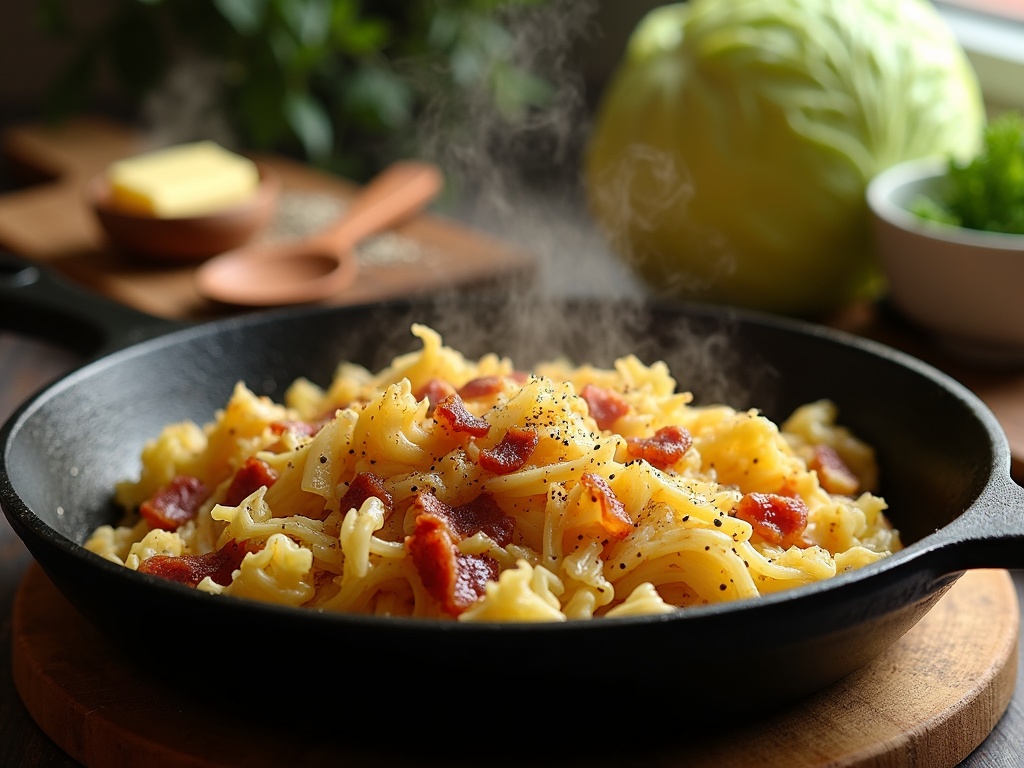
What You’ll Need for Perfect Fried Cabbage
Creating delicious fried cabbage at home is straightforward when you have the right ingredients on hand. I’ve found that a handful of quality components makes all the difference between an ordinary side dish and one that’ll have everyone asking for seconds.
Core Ingredients
The foundation of any great fried cabbage recipe starts with fresh produce and complementary flavors:
- 1 medium head of green cabbage: Look for a firm, heavy cabbage with crisp leaves. I prefer removing the tough outer leaves before chopping it into bite-sized pieces.
- 4 slices of bacon: The fat renders out during cooking, creating a flavorful base for the cabbage. Thick-cut bacon works particularly well.
- 1 diced onion: Yellow or white onions provide the perfect aromatic base.
- 2 cloves minced garlic: Fresh garlic adds depth that powdered versions can’t match.
- Salt and black pepper to taste: Season gradually as you cook to build layers of flavor.
- 1 tablespoon butter (optional): Adding butter at the end gives the dish a rich, silky finish.
Equipment Considerations
While the ingredients are simple, having the right cookware makes preparation easier. I recommend using a large, heavy-bottomed skillet or Dutch oven with plenty of surface area. This allows the cabbage to make good contact with the hot surface, developing those delicious browned edges without steaming.
A sharp knife is essential for cutting the cabbage into consistent pieces. Uneven chunks will cook at different rates, potentially leaving some pieces undercooked while others become mushy.
Don’t forget that cabbage reduces significantly in volume as it cooks. What might seem like too much raw cabbage will cook down to a perfect portion. I typically start with a pan that looks almost too full and end up with just the right amount.
For an expanded cabbage cooking experience, you might also enjoy learning how to prepare corned beef and cabbage in the oven for a heartier meal option. Or if you’re looking for a different technique, check out this method for cooking cabbage alongside corned beef that produces tender, flavorful results.
With these simple ingredients and proper equipment, you’re set to create a pan of fried cabbage that’s tender yet slightly crisp, savory, and utterly satisfying.
Steps to Make It Delicious
Preparing the Ingredients
To create a mouthwatering fried cabbage dish, I start with proper preparation. First, I cut the cabbage into bite-sized pieces, removing the tough core and outer leaves. The size of the cabbage pieces matters – they should be small enough to cook quickly but large enough to maintain texture.
Next, I prepare the bacon, which forms the flavor foundation of this dish. I’ve found that using thick-cut bacon produces the best results as it provides more fat for cooking and more substantial bacon pieces in the final dish.
I also dice an onion and mince a few cloves of garlic during this preparation stage, keeping everything ready to go before heating the pan. This preparation makes the cooking process smooth and efficient.
Cooking Process
I begin by cooking the bacon in a large skillet over medium heat until it becomes perfectly crispy. This typically takes about 8–10 minutes, depending on the thickness of the bacon. When done, I remove the bacon pieces from the skillet and set them aside on paper towels to drain excess grease.
The magic of this recipe lies in using the flavorful bacon fat left in the pan. I add the diced onions to the hot bacon grease and sauté them until they become soft and translucent, usually about 5 minutes. Then, I add the minced garlic and cook for just 1 minute – any longer and the garlic might burn and become bitter.
Now for the star ingredient – I add the cabbage to the skillet. I stir well to coat the cabbage pieces in the bacon-infused fat. This is when I might add a splash of water or chicken broth to help steam the cabbage if needed. I cook the cabbage until it’s tender but still has a slight crunch, approximately 10–15 minutes. During this time, I stir occasionally to ensure even cooking.
The final step involves bringing everything together. I crumble the crispy bacon I set aside earlier and return it to the pan. I give everything a good stir to distribute the bacon evenly throughout the cabbage. Then I season with salt and pepper to taste, sometimes adding a pinch of red pepper flakes for a mild heat.
For a complete meal featuring cabbage as a side dish, you might want to try cooking corned beef with cabbage in the oven – it’s another delicious way to enjoy this versatile vegetable.
Tips to Elevate Your Fried Cabbage
- Add a tablespoon of apple cider vinegar or a squeeze of lemon juice at the end for brightness
- Include a teaspoon of caraway seeds for an authentic European flavor
- Stir in a tablespoon of brown sugar for a hint of sweetness that balances the savory notes
- Try smoked paprika for an extra layer of flavor
- For a heartier variation, add sliced smoked sausage along with the cabbage
This fried cabbage recipe is incredibly versatile and can be adapted based on your preferences. If you’re looking for more cabbage-based dishes, learning how to cook corned beef and cabbage can give you additional ideas for working with this affordable, nutritious vegetable.
The finished dish should have a perfect balance of textures – tender yet slightly crisp cabbage, soft onions, and crunchy bacon bits – all coated in a savory, bacon-infused flavor that makes this simple dish absolutely irresistible.
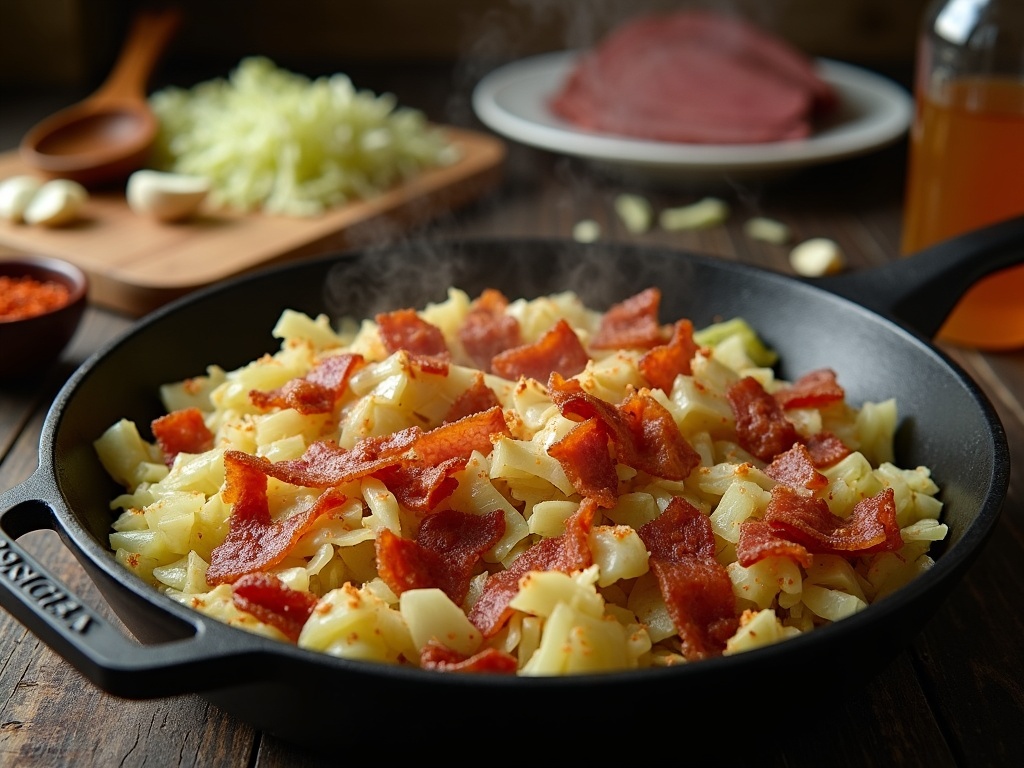
Common Mistakes to Watch For
When making fried cabbage, even small errors can make the difference between a delicious side dish and a disappointing meal. I’ve learned these lessons through plenty of trial and error in my own kitchen, and I’d like to share the pitfalls you should avoid for perfect results every time.
Cooking Missteps That Affect Your Results
Overcrowding the pan is perhaps the most common mistake I see when people try to make fried cabbage. When too much cabbage is crammed into a single pan, the vegetable releases moisture that gets trapped, causing it to steam rather than fry properly. This results in soggy, limp cabbage instead of the caramelized, slightly crisp texture that makes fried cabbage so delicious. For best results, I always use a large skillet and cook in batches if necessary.
Inconsistent cutting is another issue that can ruin your dish. When cabbage pieces aren’t cut to similar sizes, they cook at different rates. I’ve found that:
- Pieces that are too large remain raw and tough in the center
- Extremely thin pieces may burn before thicker ones are cooked
- Uneven pieces create an inconsistent texture throughout the dish
I’ve discovered that cutting cabbage into roughly 1-inch pieces provides the ideal balance between quick cooking and maintaining texture.
Cooking with excessive heat is a mistake I made frequently when first learning to cook cabbage. High heat causes the outer layers to burn while the inner parts remain undercooked. It can also cause the cabbage to release bitter compounds, affecting the overall flavor. Medium heat allows for even cooking and proper caramelization without scorching.
Neglecting to stir the cabbage occasionally leads to uneven cooking and burning on the bottom. Unlike some dishes where you want to develop a crust, fried cabbage benefits from regular stirring every minute or so. This helps distribute the heat evenly and ensures all pieces cook at the same rate. However, avoid constant stirring which prevents proper browning.
Another mistake I’ve observed is seasoning too early in the cooking process. When salt is added too soon, it draws out moisture from the cabbage, again creating a steaming effect rather than frying. I always add salt and pepper toward the end of cooking to maintain the proper texture.
Undercooking the cabbage is also problematic. Raw cabbage has a strong, sometimes sulfurous flavor that many find unpleasant. Properly cooked cabbage becomes sweeter and more mellow. You’ll know it’s done when the pieces are tender but still have a slight bite.
Using the wrong fat can impact your results too. While butter adds great flavor, it burns at lower temperatures than oils. I’ve found that a combination of butter and a higher smoke-point oil (like canola or vegetable) provides both flavor and better cooking performance.
Finally, rushing the process rarely yields good results. Properly fried cabbage takes time to develop its characteristic sweet, nutty flavor. Patience allows the natural sugars in cabbage to caramelize, creating depth of flavor that can’t be achieved with quick cooking.
By avoiding these common mistakes, you’ll be well on your way to creating perfectly fried cabbage every time. The dish is surprisingly forgiving once you understand these principles, and the results—tender, flavorful cabbage with beautifully caramelized edges—are well worth the attention to detail.
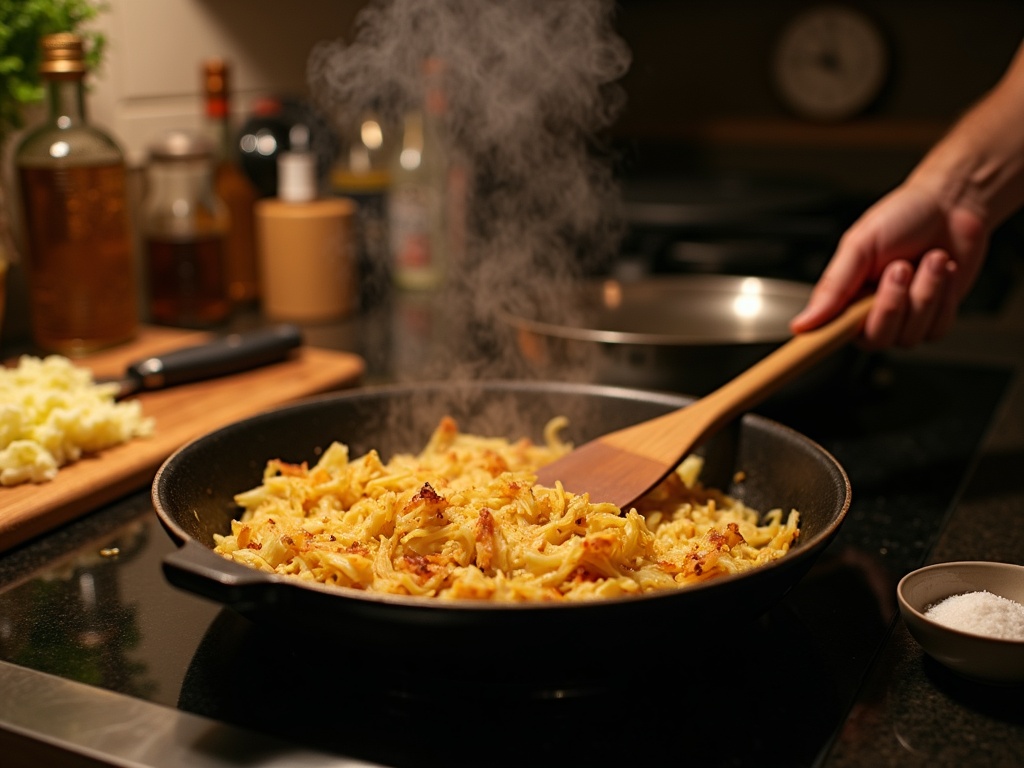
Helpful Tips for Success
Fresh ingredients make all the difference when preparing this simple yet flavorful dish. I’ve found that starting with crisp, firm cabbage heads yields the best results for any cabbage recipe – especially when frying it. The fresher your cabbage, the better texture and flavor your final dish will have.
Key Preparation Techniques
Before slicing your cabbage, don’t forget to remove the tough core completely. This part is fibrous and won’t soften properly during cooking. Simply cut the head into quarters and angle your knife to cut away the dense white core from each section. This small step ensures every bite will be tender and enjoyable.
Consistency matters when chopping your cabbage. I cut all pieces to roughly the same size – about 1-inch squares work perfectly. This uniform cutting ensures that all pieces will cook at the same rate, preventing some from burning while others remain undercooked. When your cabbage pieces are consistent, you’ll achieve that perfect balance of tenderness with slight crispness at the edges.
For authentic flavor, bacon fat is non-negotiable in traditional fried cabbage. While you could substitute other fats like butter or olive oil, the smoky depth that bacon fat adds simply can’t be matched. I save bacon drippings specifically for dishes like fried cabbage recipes – just a couple tablespoons transforms ordinary cabbage into something extraordinary. If you’re cooking bacon specifically for this recipe, cook it first and set it aside to crumble over your finished dish for added texture and flavor.
When actually frying the cabbage, patience pays off. Allow the edges to caramelize slightly before stirring. This develops those delicious browned bits that add complexity to what’s otherwise a simple vegetable side dish. Just be careful not to overcrowd your pan – cabbage releases moisture as it cooks, and too much in the pan will steam rather than fry.
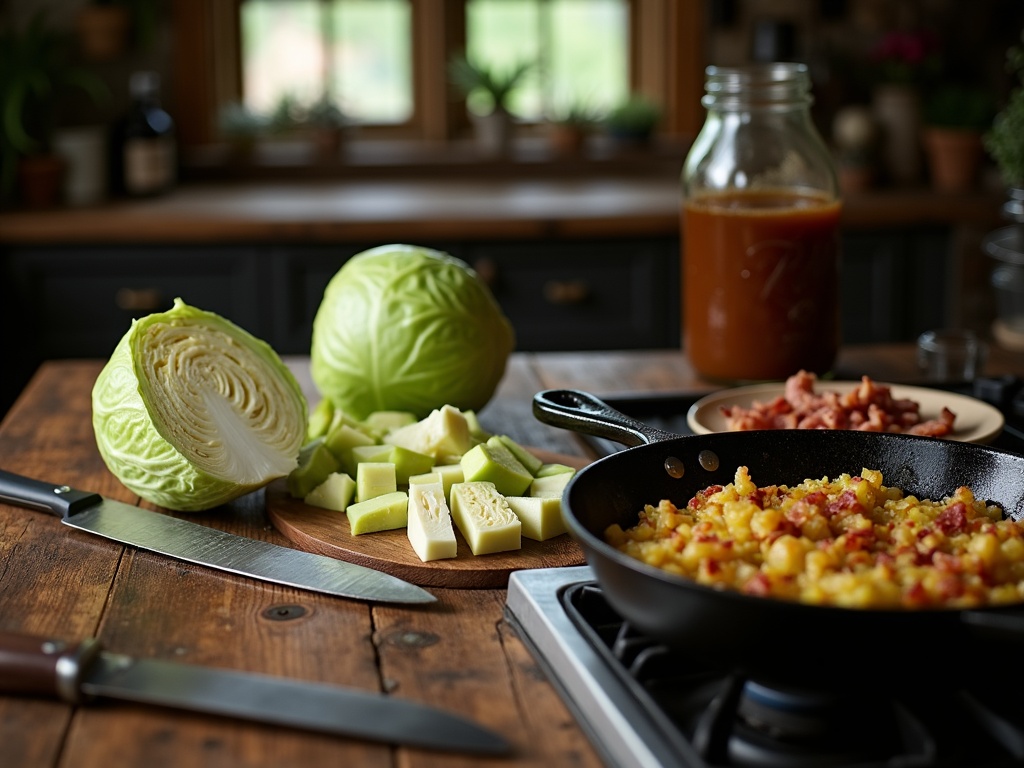
Storage and Leftovers
Properly storing fried cabbage ensures you can enjoy this flavorful dish for days after cooking. I’ve found the key is keeping it in an airtight container immediately after it cools to room temperature. This prevents the cabbage from absorbing other flavors in your refrigerator and keeps it from drying out.
Refrigeration and Reheating Tips
When stored correctly, your fried cabbage stays fresh for 3–4 days in the refrigerator. The flavors actually continue to meld during storage, often making day-two cabbage even more delicious than fresh-cooked!
For reheating, skip the microwave which can make the cabbage soggy. Instead, try these methods for the best results:
- Heat a skillet over medium heat with a small amount of butter or oil
- Add the cold fried cabbage to the hot pan
- Stir occasionally for 3–5 minutes until heated through
- Add a splash of broth or water if it seems dry
This quick skillet method revives the original texture and flavor without overcooking. If you’re looking for more cabbage inspiration, corned beef and cabbage recipes offer another delicious way to use this versatile vegetable.
Freezing is also an option if you’ve made a large batch. Simply place cooled fried cabbage in freezer-safe containers, leaving about half an inch of space at the top for expansion. It can be frozen for up to 2 months without significant quality loss. To use frozen leftovers, thaw overnight in the refrigerator before reheating using the skillet method.
The flavors in fried cabbage dishes like this pair wonderfully with many proteins. If you’re looking to create a complete meal with your leftover fried cabbage, consider serving it alongside oven-cooked corned beef for a hearty dinner option that minimizes food waste.
https://www.youtube.com/watch?v=jvGqF5WD7v4
Recipe Variations to Try
Fried cabbage offers endless opportunities for customization, making it a fantastic canvas for creative cooking. I’ve experimented with several tasty variations over the years that have transformed this simple side dish into something truly special.
Flavor Boosters and Add-ins
Adding caraway seeds brings an authentic European dimension to fried cabbage. Just a teaspoon of these aromatic seeds can transport your taste buds to a German beer garden or Polish kitchen. The seeds release their distinctive flavor when slightly toasted in the pan before adding the cabbage.
Bright orange carrot slices not only add a pop of color but also bring natural sweetness that balances the cabbage’s earthiness. Slice them thin so they cook at the same rate as the cabbage. This combination works particularly well when serving alongside corned beef from the oven.
For those who enjoy heat, red pepper flakes make an excellent addition. Start with half a teaspoon and adjust according to your spice preference. The slight kick contrasts beautifully with the natural sweetness that develops as cabbage caramelizes.
Many traditional fried cabbage recipes feature bacon, but creating a vegetarian version is simple and delicious. Replace bacon with a good quality olive oil, which lends a fruity undertone to the dish. I’ve found adding a splash of vegetable broth helps maintain that rich flavor depth. This lighter version pairs perfectly with many main courses and can easily be incorporated into a full cabbage dinner.
For an Asian-inspired twist, try adding a tablespoon of soy sauce and a teaspoon of grated ginger during the final minutes of cooking. The umami flavor melds perfectly with cabbage’s natural character.
Mixing cabbage varieties also creates interesting textural and visual appeal. Combining green cabbage with red or Napa varieties creates a more complex dish with minimal extra effort.
These variations show just how versatile this humble vegetable can be. Don’t be afraid to mix and match these ideas or add your own signature ingredients. The best recipes often come from spontaneous kitchen creativity!
What to Serve It With
Fried cabbage isn’t just a delicious side dish on its own—it pairs wonderfully with several protein options that complement its slightly sweet and savory flavors. I’ve found that the right main dish can elevate this humble cabbage recipe into a complete and satisfying meal.
Perfect Protein Pairings
Corned beef creates a classic combination that never disappoints. The salty, tender meat contrasts beautifully with the buttery texture of fried cabbage. For a complete Irish-inspired feast, you might consider trying corned beef cooked in the oven alongside your fried cabbage for a more hands-off approach.
Kielbasa brings smoky notes that complement fried cabbage perfectly. Slicing this Polish sausage and adding it directly to your cabbage during the final minutes of cooking infuses the dish with rich, savory flavor. The fat from the sausage adds an extra layer of deliciousness to your cabbage.
Roasted chicken provides a lighter alternative that still stands up to the cabbage’s flavor profile. A simple herb-roasted chicken with crispy skin offers textural contrast to the tender cabbage. For a complete meal, I suggest preparing a traditional cabbage recipe as your side dish to accompany a golden-brown roasted chicken.
When serving fried cabbage as a side, I find these protein options work best when:
- The main dish is seasoned simply to let the cabbage’s flavor profile shine
- You match cooking times so everything finishes together
- The protein has some fat content that complements the cabbage’s buttery quality
- Both dishes share at least one common seasoning element for cohesiveness
The beauty of fried cabbage lies in its versatility—it can transform from a humble side dish to a starring role depending on what you serve alongside it and how you season it.

